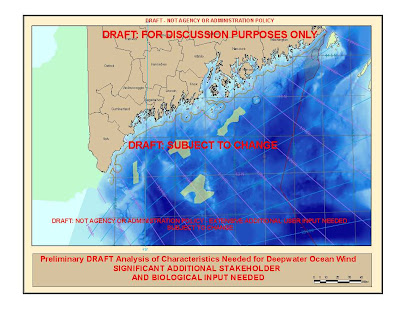Learn what places the state has picked so far and listen to the speakers at the federal/state ocean energy task force meeting held at the statehouse in Augusta on Tuesday, November 16, 2010.
Click here or scroll down this page.
Four important facts to come out of the meeting:
1.
The map below is the state's first rough cut of suitable areas, s supplied to the meeting by Matt Nixon, GIS specialist for State Planning office. It shows four potential deepwater ocean wind areas off Midcoast and Southern Maine. His preliminary review of Gulf of Maine trawl and dredge fishery VMS tracking data and commercial shipping use data.
Achieving the status of potential locations for ocean windfarming are: a location east of the northern half of
Jeffrey's Ledge; one between Fippennies Bank and Cashes Ledge; one between
Platts Bank and the
Harris Ground, and one between
the Bounties and the
Clay Bank offshore of Penobscot Bay.
the Baldacci Administration's nervousness about picking offshore windmill locations, by being stamped in red multiple times with such qualifiers as "DRAFT: Not Agency or Administration Policy" and "Significant Additional Stakeholder and Biological Input needed", "Draft: For discussion purposes only", and SUBJECT TO CHANGE." Nothing is final yet, Nixon insists: "Extensive additional user input needed". OK, Matt, we get it!

2. At least three companies have written the Bureau of Parks and Lands expressing interest in building and operating ocean windmills in federal waters off Maine. That according to Dan Prichard of the Bureau of Parks and Lands, who would not identify the companies or their desired locations locations, stating confidentiality of ongoing negotiations
3. NEFMC tucks tail. The New England Fishery Management Council, has opted out of participating in oversight of this fishing ground takeover. This from Paul J. Howard,
Council's executive director. Howard says that while he's has been receiving calls from officials of the three New England states where BOEMRE is running interagency task forces (Massachusetts, Rhode Island and Maine) asking the NEFMC to get involved, "the Council does not have the resources to do so."
Howard wrote that is was good enough that NMFS's Northeast regional office participates in the BOEMRE task forces,, noting however, that NMFS regional administrator Pat Kurkul "suggested we are better off getting involved with NROC (Northeast Regional Ocean Council) than individual task forces." But Howard notes that "NROC is not coordinating these activities following the newly signed Presidential Executive Order about ocean planning". NROC is a state/federal partnership created in 2005 to "engage in regional protection and balanced use of ocean and coastal resources" by the six New England states. So nobody appears to be guarding the Gulf of Maine fisheries chicken coop from the energy foxes? !
4th the state may sign a revised "
Letter of Intent to Coordinate Review and Approval Processes"(pdf) with the federal Bureau of Ocean Energy. This is much more of a legal document than the now renamed "charter" of the last meeting, Listen below to Audio Parts 14 and 15 for details on the changes the state requested be made in the letter.
New Lepage Administration Tilberg, a special advisor to outgoing governor John Baldacci, will be departing her post as state lead in the BOEMRE process at the end of the year. Kathleen Leyden, head of Maine coastal program will replace her pro-tem, but look to the Lepage Administration making its own picks for marine resource, coastal program, and ocean energy leadership slots
Offshore wind IS a marine resource. We've seen the results when other newly exploited marine resources get piled on by everyone who can afford to be out there. While the agencies stress that nothing is settled, the process is similar to the one used to select waters off Monhegan, Boon and Damariscove Islands for ocean windpower test sites. Things are moving quickly, and with few exceptions, the public has not been watching its public servants working on this planned major change in ocean management. And they've gotten to be "uppity servants", secure in their tenure,
The greatest environmental protection brought to the Gulf of Maine by Maine's Coastal Program &Seagrant/Cooperative extension, are their
almost perfect inertia No matter what committees or task forces the Maine legislature spawns, no matter how many powerpoint sessions Maine's dedicated circus troupe of ocean and coastal planning bureaucrats host up and down our coast, the results will be the same:
A glossy coffeetable book-sized report, calls for more funding to allow the Coastal Program/Cooperative Extension/Seagrant community and their private consultant allies to trek from catered meeting to catered meeting. For more study. And then....Nothing.
For when it comes to such potentially threatening energy extractive industries to our Gulf of Maine as industrial class wind and tidal power extraction, (or on such matters as aquaculture, marine protected areas & "bay management") Coastal Program & Co seem to have adapted and revised the Hippocratic: "first do nothing harmful!" philosophy to "First do nothing!". It is a strategy that has been phenomenally successful in thwarting efforts to manage human impacts on the se waters and their wild inhabitants.
MEETING RECORDINGS (mp3s)









